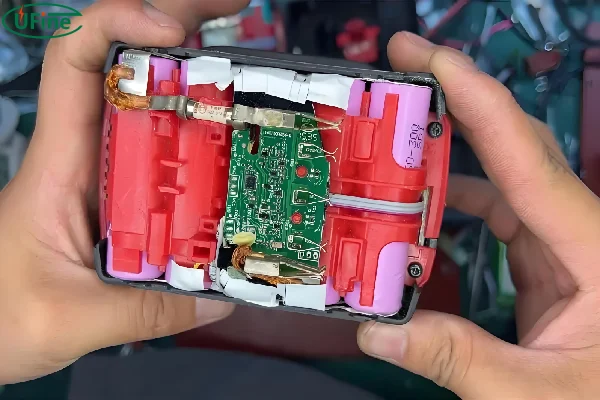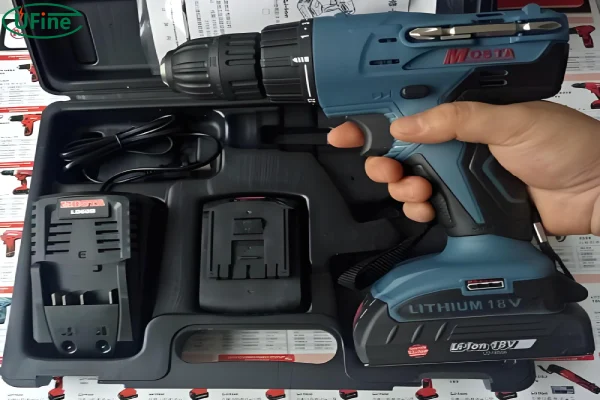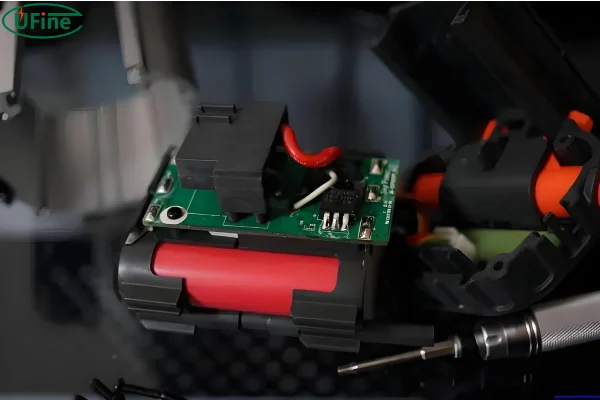
- Part 1. what are 18V batteries?
- Part 2. Types of 18V batteries
- Part 3. Pros and Cons of using 18V batteries
- Part 4. Comparing 18V batteries to other voltage options
- Part 5. Charging techniques for maximum efficiency
- Part 6. Key features to buy 18V batteries
- Part 7. Selecting the right 18V battery for your needs
- Part 8. Common issues and troubleshooting
Part 1. what are 18V batteries?
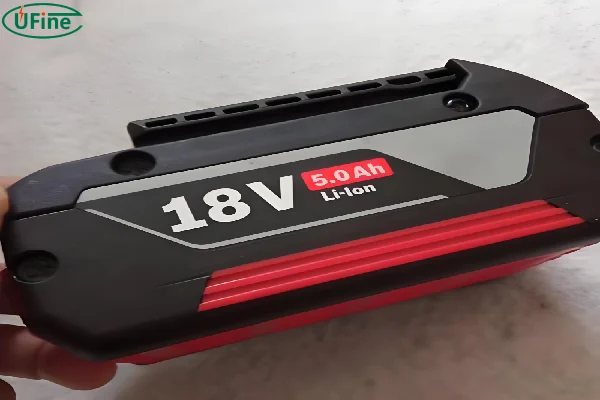
18V batteries have become a cornerstone in the realm of cordless power tools, earning widespread acclaim from both professionals and DIY enthusiasts. These batteries are distinguished by their voltage level, which signifies a higher power capacity compared to many other models. The significance of 18V lies not just in its numeric value but in the capabilities it unlocks for a range of tools and applications.
In the world of power tools, battery voltage is a key determinant of performance. Higher voltage batteries, like the 18V, offer the benefit of generating more torque and power output, which is essential for demanding tasks. This makes them particularly suitable for heavy-duty operations such as drilling, sawing, and impact driving.
Part 2. Types of 18V batteries
Three primary types of 18V batteries are commonly used in power tools: Nickel Cadmium (NiCd), Nickel Metal Hydride (NiMH), and Lithium-Ion (Li-Ion). Each type brings unique characteristics and performance metrics that suit different applications and user preferences.
Nickel Cadmium (NiCd) Batteries
Nickel Cadmium batteries were among the first rechargeable batteries used in power tools. They offer robust performance and durability.
-
Durability: NiCd batteries are known for their long life and ability to withstand extreme conditions.
-
Performance: They maintain steady voltage output and deliver consistent power.
-
Memory Effect: One significant drawback is the memory effect, which can reduce capacity when recharged before completely discharged.
-
Environmental Impact: NiCd batteries contain toxic heavy metals, requiring special disposal procedures.
Nickel Metal Hydride (NiMH) Batteries
Nickel Metal Hydride batteries emerged as a more environmentally friendly option compared to NiCd batteries. They offer several advantages that make them a popular choice for many users.
-
Lower Memory Effect: Compared to NiCd batteries, NiMH batteries have a significantly reduced memory effect.
-
Higher Capacity: They provide higher energy density, allowing for longer use between charges.
-
Environmental Impact: NiMH batteries contain fewer toxic materials, making them less harmful to dispose of.
-
Shelf Life: They have a shorter shelf life and can self-discharge more rapidly than other types.
Lithium-Ion (Li-Ion) Batteries
Lithium-Ion batteries represent the most advanced technology among 18V batteries. Their features align well with the demands of modern power tool users.
-
Higher Energy Density: Li-Ion batteries offer the highest energy density, providing longer run times and more power.
-
Low Self-Discharge: They exhibit minimal self-discharge, retaining charge well when not in use.
-
No Memory Effect: Li-Ion batteries do not suffer from memory effect, maintaining full capacity regardless of charge cycle.
-
Lightweight: They are lighter than NiCd and NiMH batteries, enhancing tool ergonomics.
-
Cost: Despite their benefits, Li-Ion batteries are more expensive but offer superior performance and longevity.
Understanding these different types of 18V batteries can help users select the most suitable option for their needs, balancing factors such as performance, durability, environmental impact, and cost.
Part 3. Pros and Cons of using 18V batteries
Evaluating the merits and drawbacks of 18V batteries can provide deeper insights for consumers.
Pros
-
Power Output: The 18V battery often delivers more substantial power output relative to its lower voltage counterparts, making it ideal for demanding applications.
-
Endurance: These batteries typically offer long-lasting operational time, reducing the need for frequent recharges during extensive tasks.
-
Compatibility: An extensive range of power tools are designed to be compatible with 18V batteries, making them versatile across numerous applications.
-
Recharge Speeds: Generally, 18V batteries feature advanced technology that allows for faster recharging times, minimizing downtime.
-
Weight-to-Power Ratio: They strike a good balance between weight and power, being less cumbersome while still robust enough for heavy-duty use.
-
Durability: Constructed with superior materials, 18V batteries exhibit enhanced durability and reliability over prolonged periods.
Cons
-
Initial Cost: The upfront investment for 18V batteries can be higher compared to lower voltage options due to their advanced capabilities and quality.
-
Size and Weight: Although reasonably balanced, they may still be bulkier and heavier than lower voltage batteries, potentially impacting maneuverability for some users.
-
Heat Generation: These batteries can generate considerable heat during intense use, necessitating efficient cooling mechanisms to ensure optimal performance and safety.
-
Environmental Impact: Manufacturing 18V batteries involves significant resource usage and produces waste, contributing to environmental concerns.
-
Specificity: Despite their broad compatibility, there still exist certain tools and devices that necessitate alternate voltage specifications, occasionally limiting their applicability.
Part 4. Comparing 18V batteries to other voltage options
When analyzing the performance of 18V batteries against other voltage options, several key factors come into play, including power output, portability, and compatibility. Each voltage class offers distinct benefits and limitations based on these criteria.
Power Output
Power output directly relates to the tasks batteries can handle. Higher voltage options such as 36V or 40V typically offer more significant torque and power, suited for heavy-duty tools like chainsaws and high-capacity drills. Conversely, lower voltage options, such as 12V and 10.8V batteries, are sufficient for lighter tasks like small screwdrivers or lighting equipment.
Portability
Portability is another essential factor when considering battery options. Lower voltage batteries, such as 12V models, are lighter and more compact, making them ideal for prolonged use in less intensive tasks. In contrast, while 36V and 40V batteries provide increased power, they are usually bulkier and heavier, potentially leading to user fatigue during extended use. The 18V battery strikes a balance, offering considerable power without compromising on portability significantly.
Compatibility
Compatibility with existing tools and systems is a crucial consideration. Batteries with lower voltages tend to be compatible with smaller, less powerful tools, while higher voltage options align with high-performance equipment. The 18V battery occupies a middle ground, providing versatility by powering a broad range of tools across various brands, including drills, saws, and impact drivers. This flexibility makes it a preferred choice among professionals and DIY enthusiasts alike.
Battery Life and Charging
Battery life and charging times are also vital. While higher voltage batteries can offer longer runtimes, they often come with longer charging times. Lower voltage batteries charge faster but may deplete quickly under intensive use. The 18V battery offers a balanced charging time and efficiency, making it a dependable option for most applications.
Shelf Life
Shelf life determines how long a battery can retain its charge when not in use. Lower and higher voltage batteries can suffer from quicker drain over time if not properly maintained. The 18V batteries, benefiting from advancements in lithium-ion technology, often maintain charge better, ensuring readiness for spontaneous use.
Part 5. Charging techniques for maximum efficiency
Optimizing the charging process is crucial for ensuring the longevity and performance of an 18V battery. Here are some key strategies:
-
Use Manufacturer-Recommended Chargers
-
Always use chargers recommended by the manufacturer.
-
These chargers are specifically designed to optimize the charging process for that particular battery type.
-
They ensure the voltage and current are within safe limits, preventing damage and overheating.
-
-
Follow Proper Charging Cycles
-
Allow the battery to cool down before recharging if it has been used extensively.
-
Properly timed charging cycles prevent thermal stress on battery cells.
-
Avoid charging the battery just before use, as it may not have adequate time to cool down.
-
-
Utilize Smart Chargers
-
Smart chargers can detect the battery’s status and adjust the charging rate accordingly.
-
These chargers often feature multiple stages, such as fast charging initially and trickle charging towards the end.
-
They help to prevent overcharging and extend battery lifespan.
-
-
Avoid Overcharging
-
Disconnect the battery once it is fully charged.
-
Overcharging can lead to reduced battery capacity and overheating.
-
Some chargers have auto cut-off features to prevent overcharging.
-
-
Store Batteries Properly
-
Store batteries in a cool, dry place.
-
Extreme temperatures can adversely affect battery health.
-
Ideally, batteries should be stored at 40-60% charge level if not being used for extended periods.
-
-
Regular Maintenance
-
Periodically clean the battery terminals.
-
Ensure the charger connections are free from dust and debris.
-
Regular maintenance reduces resistance and improves efficiency.
-
Adhering to these charging techniques not only maximizes the efficiency of an 18V battery but also prolongs its operational life. Ensuring that the battery is charged correctly enhances tool performance, reduces downtime, and contributes to safer operational practices.
Part 6. Key features to buy 18V batteries
Compatibility and Versatility
-
Ensure the battery is compatible with a wide range of tools.
-
Look for universal connectors that fit various brands.
-
Check for seamless integration with existing tool sets.
Capacity and Runtime
-
Review the ampere-hour (Ah) rating; higher Ah provides longer runtime.
-
Consider runtime projections for various tasks.
-
Verify the battery’s ability to maintain consistent output over extended periods.
Charging Efficiency
-
Check for rapid-charging capabilities.
-
Evaluate the charging time from 0% to 100%.
-
Investigate smart features like automatic shutoff and temperature control during charging.
Durability and Build Quality
-
Inspect the construction materials for robustness.
-
Look for weather-resistant and drop-tested batteries.
-
Consider warranties and the manufacturer’s reputation for quality.
Weight and Ergonomics
-
Assess the battery’s weight and its impact on tool balance.
-
Ensure ergonomic features for comfortable handling.
-
Look for compact designs that fit snugly in various power tools.
Safety Features
-
Check for overcharge and over-discharge protection.
-
Look for built-in short circuit and temperature sensor protections.
-
Consider advanced features like cell balancing and thermal regulation.
Energy Efficiency
-
Evaluate the battery’s energy transfer efficiency.
-
Check for low self-discharge rates when not in use.
-
Investigate eco-friendly design elements like recycling eligibility and reduced carbon footprint.
User Interface and Indicators
-
Look for charge level display indicators.
-
Assess ease of use, such as one-touch battery removal.
-
Consider additional features like app compatibility for monitoring.
Cost-effectiveness
-
Compare the cost relative to performance and features offered.
-
Assess long-term savings from prolonged battery life and efficiency.
-
Consider promotional bundles or manufacturer discounts.
Replacement and Availability
-
Verify the ease of obtaining replacement batteries.
-
Check for widespread availability across various retailers.
-
Investigate the availability of aftermarket alternatives.
Part 7. Selecting the right 18V battery for your needs
Choosing the appropriate 18V battery is crucial for ensuring optimal performance and efficiency. Users should consider several factors before investing in an 18V battery model. Here is a detailed breakdown of what to evaluate:
-
Capacity (Ah)
-
A higher amp-hour (Ah) rating indicates a longer run-time.
-
Users needing extended use for demanding tasks should opt for batteries with higher Ah ratings.
-
-
Voltage Compatibility
-
Ensure compatibility with existing tools.
-
Most 18V batteries fit a broad range of tools from the same brand, fostering versatility.
-
-
Brand and Quality
-
Trusted brands often provide more reliable batteries.
-
Check reviews and ratings for the brand’s reputation and battery performance.
-
-
Battery Type
-
Lithium-ion (Li-ion) batteries are light, provide longer run-time, and have better energy density compared to Nickel-Cadmium (NiCd) batteries.
-
Users should compare the pros and cons of Li-ion and NiCd types based on their needs.
-
-
Charging Time
-
Consider the battery’s charging time, especially for high-frequency use.
-
Fast-charging capabilities can increase productivity and reduce downtime.
-
-
Weight and Ergonomics
-
Lightweight batteries reduce user fatigue during extensive use.
-
Ensure the battery design is ergonomic and fits comfortably in the tool.
-
-
Price and Warranty
-
Evaluate if the price aligns with the budget and the battery’s features.
-
A solid warranty can indicate quality and provide assurance for users.
-
-
Extra Features
-
Look for features like built-in indicators for battery life.
-
Some batteries offer protection circuits to guard against overheating and overcharging, enhancing safety.
-
Selecting an 18V battery that best matches the specific requirements can significantly influence the performance and longevity of the tools in use. Taking time to research and compare options will lead to more informed and satisfying decisions.
Part 8. Common issues and troubleshooting
When using an 18V battery, several common issues may arise, each with potential solutions. Proper troubleshooting can ensure long-lasting battery performance.
Battery Not Charging
-
Check Connections: Ensure the battery is firmly connected to the charger. Loose connections can prevent proper charging.
-
Inspect Charger: Examine the charger for signs of wear or damage. A faulty charger can impede charging.
-
Test Outlet: Verify that the power outlet is functioning correctly. Plugging into a different outlet can sometimes resolve charging issues.
Shortened Battery Life
-
Temperature Considerations: Avoid exposing the battery to extreme temperatures. Both heat and cold can negatively affect performance and longevity.
-
Use Consistency: Frequent, heavy use can strain the battery. Try to moderate usage to extend battery life.
-
Proper Storage: Store the battery in a cool, dry place when not in use. This helps maintain optimal performance.
Overheating
-
Cooling Periods: Allow the battery to cool down between uses. Continuous operation can lead to overheating.
-
Ventilation: Ensure proper ventilation during use. Poor airflow can contribute to overheating.
-
Tool Compatibility: Check if the battery is compatible with the tool in use. Mismatched tools can cause excessive heat.
Power Loss During Operation
-
Inspect Cells: Battery cells can degrade over time. If experiencing power loss, it might be time to inspect or replace individual cells.
-
Maintenance: Regularly clean the battery contacts to ensure optimal conductivity. Dust and debris can interfere with power delivery.
-
Age Factor: Batteries naturally wear out. If the battery is old, it may no longer hold a charge as effectively.
Indicator Light Issues
-
Reference Manual: Consult the user manual for specific indicator light meanings. Different models may have unique signal systems.
-
Reset: Sometimes, performing a reset can resolve indicator light anomalies. Follow the manufacturer’s instructions for resetting.
-
Firmware Updates: Check for firmware updates if the battery and charger support it. Updates can resolve indicator issues.
Manufacturers like Ufine Battery continue to innovate, improving the efficiency and functionality of these batteries. With advancements such as lithium-ion technology, 18V batteries are now more lightweight and compact without compromising on power. Furthermore, safety features like overload protection and thermal monitoring systems ensure reliable operation, reducing the risk of overheating or failure.
Overall, understanding the intricacies of 18V batteries provides insight into why they outperform other models. They represent a blend of power, efficiency, and advanced technology, making them indispensable in various professional and recreational settings.
Related Tags:
More Articles
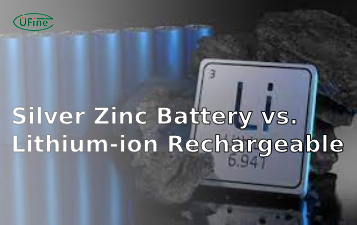
What is the Difference Between Silver Zinc Battery vs. Lithium-ion Rechargeable?
Compare silver zinc and lithium-ion rechargeable batteries: energy density, cycle life, safety, cost, and uses in drones, medical devices, EVs, and electronics.
What are Watts and Watt Hours in Battery?
Understand watt vs watt-hour in batteries: key differences, how to calculate capacity, and why they matter. Includes free comparison table.
Best 10 Blood Pressure Monitor Battery Review: Finding the Most Reliable
Are you looking for a reliable Blood Pressure Monitor battery? Here is a complete guide with the top 10 best blood pressure monitor batteries.
Bluetooth Headphone Battery Guide: All You Need to Know
Maximize headphone battery life with expert tips! Learn how to charge, check, troubleshoot, and choose the best bluetooth headphone battery in 2025.
LiFePO4 Battery VS. Lithium-ion Polymer Battery: Which One Is Best?
Comprehensive comparison of LiFePO4 vs Lithium Ion Polymer batteries: energy density, safety, lifespan, cost. Find out which battery suits your needs in 2025.
